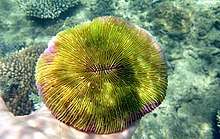Danafungia scruposa
Danafungia scruposa is a species of coral that is the first to have been observed to eat jellyfish.[3] It was described by Klunzinger in 1879 and has a diameter of around 25 centimetres (9.8 in). It is rated as a least-concern species.
| Danafungia scruposa | |
|---|---|
 | |
| Danafungia scruposa, Russell Island, Australia | |
| Scientific classification | |
| Kingdom: | Animalia |
| Phylum: | Cnidaria |
| Class: | Anthozoa |
| Order: | Scleractinia |
| Family: | Fungiidae |
| Genus: | Danafungia |
| Species: | D. scruposa |
| Binomial name | |
| Danafungia scruposa (Klunzinger, 1879)[2] | |
| Synonyms | |
|
List
| |
Description
They are around 25 centimetres (9.8 in) in diameter and normally eat a variety of food from bacteria to mesozooplankton measuring 1 mm in diameter. During an algal bloom in 2009 researchers observed the coral consuming the jellyfish Aurelia aurita. This was the first time such behaviour has been seen in the wild. It is not known how the coral captures jellyfish.[4] This coral is unusual in that it consists of a single polyp up to 25 centimetres (9.8 in) across. It may have caught the jellyfish with its tentacles in the same way as some sea anemones feed on other jellyfish species.[3]
Its polyps have diameters of up to 240 millimetres (9.4 in) and are oval or circular. The species may contain tentacular lobes and it has dense septa. It is blue or brown in colour.[5] Its maximum diameter is around 38 centimetres (15 in).[1]
Distribution
D. scruposa is found in the eastern and western Indian Ocean, the eastern central, northwestern and western central Pacific Ocean, Japan, the East China Sea, the Red Sea, and eastern Australia.[1] No population figures are available for the species but it is believed to be common and is found at depths between 1 and 27 metres (3 ft 3 in and 88 ft 7 in) on the slopes of reefs. A 1991 study of specimens found that 51% were bleached. It is threatened by bleaching, disease, climate change, fishing, preadators, and human activities. F. scruposa is classified as a least concern species by the IUCN.[1]
Taxonomy
It was originally described by Klunzinger in 1879 as Fungia scruposa.[2] The species is also known by synonym Fungia corona (Döderlein, 1901).[1]
References
- "Fungia scruposa". IUCN Red List of Threatened Species. Retrieved 17 August 2015.
- WoRMS (2018). "Danafungia scruposa (Klunzinger, 1879)". WoRMS. World Register of Marine Species. Retrieved 2018-07-25.
- Bourton, Jody (13 November 2009). "Predatory coral eats jellyfish". BBC News. Retrieved 15 November 2009.
- Alamaru, A; Bronstein, O; Dishon, G; Loya, Y (December 2009). "Opportunistic feeding by the fungiid coral Fungia scruposa on the moon jellyfish Aurelia aurita". Coral Reefs. 28 (4): 865. Bibcode:2009CorRe..28..865A. doi:10.1007/s00338-009-0507-7.
- "Fungia scruposa". Australian Institute of Marine Science. Retrieved 17 August 2015.
